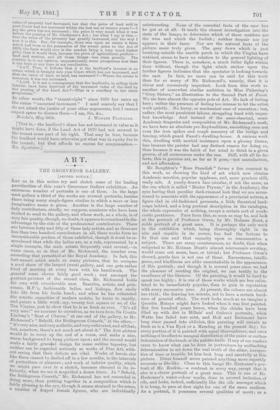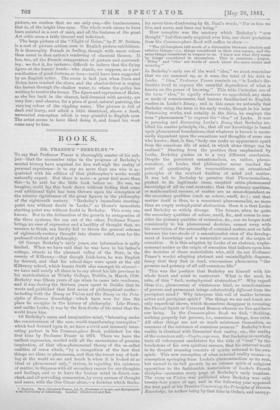ART.
THE GROSVENOR GALLERY.
LSECOND NOTICE.]
LET us in this notice try and sketch some of the leading peculiarities of this year's Grosvenor Gallery exhibition. An enormous number of portraits is one of them. In the large -west gallery a third of the works are avowed portraits, besides there being many single-figure studies to which a more or less atuaginative name is given. Another is the large number of lady contributors, chiefly, we suppose, amateurs who have been invited to send to the gallery, and whose work, as a whole, is of .very fair quality, though, no doubt, it appears to considerable dis- advantage by the side of the professional contributors. There are between forty and fifty of these lady artists, and as there are less than two hundred contributors in all, these works form no =considerable portion of those exhibited, though it must be re- membered that while the ladies are, as a rule, represented by a Lingle example, the male artists frequently send several,—in some cases, as in that of Mr. Richmond, the number even exceeding that permitted at the Royal Academy. In fact, this dad-named artist sends so many pictures, that he occupies a good share of the largest (west) gallery, and one gets rather tired of meeting at every turn with his handiwork. The .general mass shows fairly good work ; and amongst the portrait-painters of the second class, Mr. Richmond holds his own with considerable ease. Beauties, artists, and prin- cesses, M.P.'s, fashionable ladies, and bishops, flow easily auto life from his facile hand ; and when he has exhausted the artistic capacities of modern society, he turns to rapidly, .and paints a little work, say, twenty feet square or so, of the Tea Virgins, just to show that be is as fresh as ever. "It's all very nice!" we murmur to ourselves, as we turn from Sir Coutts Lindsay's "Boat of Charon," at one end of the gallery, to Mr. Richmond's " Behold, the Bridegroom Cometh," at the other,- " it's very nice, and very msthetic, and very cultivated, and all that; but, somehow, there's not much art about it." The first picture vosild do to cover up the end of a room, and make a nice, warm background to hang pictures upon; and the second would make a fairly graceful design for some outline tapestry, but neither can be regarded seriously as works of Fine Art, with- -out seeing that their defects are vital. 'Works of heroic size like these cannot be dashed off in a few months, in the intervals of portraiture or pleasure ; and work of inferior quality, which we might pass over iu a sketch, becomes clamant in its in- feriority, when we see it magnified a dozen times. In "Behold, the Bridegroom Cometh," Mr. Richmond has not succeeded in doing more, than putting together in a composition which is fairly pleasing to the eye, though it seems strained to the sense, tt number of draped female figures, who aro individually
uninteresting. None of the essential facts of the case has he got at at all. It needs the closest investigation into the state of the lamps, to determine which of these maidens are the wise and which the foolish ; neither despair nor joy•
appears in their faces. Nor are the natural facts of the picture more truly given. The grey dawn which is just breaking outside the marble porch in which the Virgins have watched, seems to have no relation to the general lighting of their figures. There is, somehow, a much fuller light within than without, though the light which strikes upon the further figures indicates that the spectator is looking towards the east. In fact, no more can be said for this work than for so many of Mr. Richmond's, namely, that it is clever and excessively imperfect. Look from this work to
another of somewhat similar ambition in Miss Pickering's " Grey Sisters," an illustration to the Second Part of Faust.
We see here almost the opposite pole of Art. No lack of feeling hero ; rather the presence of feeling too intense to let the artist work quietly. No hurry, or mechanical ease of execution ; but, rather, the most persistent labour, struggling hard with imper- fect knowledge. And instead of the semi-classical, semi- Academic draperies and composition of Mr. Richmond's work, we have here an absolute pre-Raphaelitism, smoothing over not even the iron spikes and rough masonry of the bridge and fencing, which guard Faust's dwelling-house. A curious work this, dwelling with morbid insistence upon a gloomy theme, less because the painter had any distinct reason for doing so, than because it was the habit of her mind to think in a given groove, of all occurrences under the sun. Still, with all its de- fects, this is genuine art, as far as it goes,—not manufacture, and not affectation.
Mr. Boughton's "Rose Standish" forme a fine contrast to this work, as showing the kind of art which now obtains Academic sanction, popular applause, and, more precious still, ready sale. A poorly-drawn face (similar, if not the same, as the one which is called " Hester Prynne," in the Academy), the eyes having that peculiar dark-rimmed look that wo are accus-
tomed to associate with the appearance of a provincial actress, a figure clad in old-fashioned garments, a little theatrical land-
scape behind, and a long poetical description in the catalogue, the whole expressive of nothing, except a certain sort of mock- rustic prettiness. Turn from this, as soon as may be, and look at the portrait of Professor Owen, by Mr. Holman Hunt, a noble portrait of a great man. It is perhaps the only work iu the exhibition which, being thoroughly right in its aim and capable in its power, has had the fortune to fix that aim and that capacity upon so remunerative a subject. There are many countenances, no doubt, that when subjected to Mr. Holman Hunt's almost microscopic scrutiny, would come out mean, base, or trivial; but Professor Owen's shrewd, gentle face is not one of these. Earnestness, intelli- gence, and kindliness are alike unmistakable in the appearance.
of this portrait ; and though it is several years since we had the pleasure of meeting the original, we can testify to time excellence of the likeness. Of the painting, it would be bard to speak too highly ; it is one of those works which are less calcu- lated to be immediately popular, than to gain in reputation with every successive year. At present, the colours are almost too vivid ; the drawing too minute, not to have a certain hard- ness of general effect. The work looks much as we imagine a Quentin Matsys might have looked when it was first painted.
But five hundred years hence, when the chinks have been filled up with dirt in Millais' and Ouless's portraits, when Watts has faded into mist, and Hell and Richmond have long since passed into oblivion, this painting will remain as fresh as is a Van Eyck or a Memling at the present day; for every portion of it is painted with equal thoroughness, and owes nothing of its effect to unequal distribution of the paint or surface indentation of the brush or the palette-knife. If any of our readers cares to know what can be done in portraiture by unflinching determination to set down the real truth of the sitter, irrespec- tive of time or trouble, let him look long and carefully at this picture. Darer himself never painted anything more superbly accurate or life-like. Close to this hangs Mr. Herkomer's por- trait of Mr. Ruskin,—a contrast in every way, except that it also is a clever portrait of a great man. This is one of Mr.
Herkomer's water-colour works, done in avowed imitation of oils, and looks, indeed, sufficiently like the oils amongst which it is hung, to pass at first sight for one of the same medium. As a portrait, it possesses several qualities of merit ; as a picture, we confess that we see only one,—the luminousness, that is, of the bright blue eyes. The whole work seems to have been painted in a sort of mist, and all the features of the great Art critic seem a trifle blurred and indistinct.
The large picture of the "Flight of Helen," by F. W. Britten, is a sort of picture seldom seen in English picture exhibitions. It is thoroughly French in feeling, though with more colour than usual in that nation's rendering of classical themes. It has, too, all the French exaggeration of gesture and surround- ing; we find it., for instance, difficult to believe that the flying figure at the horses' heads—who stands, we suppose, as a per- sonification of good-fortune, or love—could have been suggested by an English artist. The scene is laid just when Paris and Helen have reached the shore, and the chariot-driver is urging the horses through the shallow water, to where the galley lies waiting to receive the lovers. The figure and expression of Helen, as she lies back in the chariot, hall-frenzied with anxiety, are very fine ; and observe, for a piece of good, natural painting, the varying colour of the rippling water. The picture is full of dash and hurry, and albeit a little theatrical, shows a fresh, unwearied conception which is very grateful to English eyes. The artist seems to have liked doing it, and found his work come easy to him.



































 Previous page
Previous page